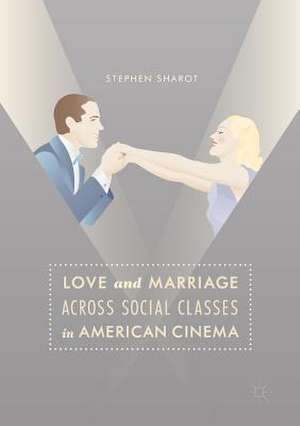Love and Marriage Across Social Classes in American Cinema
Autor Stephen Sharoten Limba Engleză Paperback – 11 iul 2018
Preț: 197.49 lei
Nou
Puncte Express: 296
Preț estimativ în valută:
37.81€ • 39.30$ • 31.35£
37.81€ • 39.30$ • 31.35£
Carte tipărită la comandă
Livrare economică 07-21 februarie 25
Preluare comenzi: 021 569.72.76
Specificații
ISBN-13: 9783319824321
ISBN-10: 3319824325
Pagini: 273
Ilustrații: XIX, 273 p. 26 illus.
Dimensiuni: 148 x 210 mm
Greutate: 0.35 kg
Ediția:Softcover reprint of the original 1st ed. 2017
Editura: Springer International Publishing
Colecția Palgrave Macmillan
Locul publicării:Cham, Switzerland
ISBN-10: 3319824325
Pagini: 273
Ilustrații: XIX, 273 p. 26 illus.
Dimensiuni: 148 x 210 mm
Greutate: 0.35 kg
Ediția:Softcover reprint of the original 1st ed. 2017
Editura: Springer International Publishing
Colecția Palgrave Macmillan
Locul publicării:Cham, Switzerland
Cuprins
Preface.- 1. Love, Marriage and Class.- 2. Before the Movies: The Cross-Class Romance in Fiction.- 3. From Attraction and the One-Reeler to the Feature.- 4. Sexual Exploitation and Class Conflict.- 5. Consumerism and Ethnicity.- 6. The Cross-Class Romance in the Depression.- 7. Male Seducers and Female Gold-Diggers.- 8. The End of the Golden Era and After.
Recenzii
“Stephen Sharot, professor of sociology and anthropology at Ben-Gurion University, presents here the first comprehensive and systematic study of cross-class romance films throughout the history of American cinema. … Love and Marriage Across Social Classes is a great journey.” (John A. Dick, Marriage, Families & Spirituality, Vol. 29 (1), 2023)
“This book is useful for American cinema scholars for its encyclopedic coverage of these films and for the patterns it observes across the quantity of films it explores. Sharot also provides enough context of both developments in the film industry … . Accomplishing much more than merely a history of a prominent film subgenre, the book joins the complex historical and sociological conversation about class and gender in twentieth-century America.” (Paul Arras, Journal of Popular Culture, 2018)
Notă biografică
Stephen Sharot (D.Phil. Oxford) is Emeritus Professor of Sociology at Ben-Gurion University of the Negev. His research focuses on representations of class and their relationships to gender in popular cinema. He is the author of five books and numerous articles in the sociology of religion.
Textul de pe ultima copertă
This book is the first comprehensive and systematic study of cross-class romance films throughout the history of American cinema. It provides vivid discussions of these romantic films, analyses their normative patterns and thematic concerns, traces how they were shaped by inequalities of gender and class in American society, and explains why they were especially popular from World War I through the roaring twenties and the Great Depression. In the vast majority of cross-class romance films the female is poor or from the working class, the male is wealthy or from the upper class, and the romance ends successfully in marriage or the promise of marriage.
Caracteristici
First comprehensive and systematic historical survey of American films centering on cross-class romance Outlines in detail the most important narrative patterns and thematic concerns of cross-class romance films, emphasizing both continuities and changes in these patterns and concerns over the decades Contextualizes the films with reference to the structure and operations of the American film industry, their reception, the personas of the stars who appeared in them, and the social realities of working life, dating, and marriage in American society
